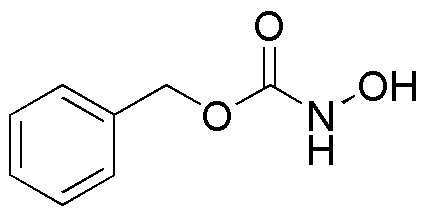N-(Benzyloxycarbonyl)hydroxylamine is widely utilized in research focused on:
- Pharmaceutical Development: This compound serves as an important intermediate in the synthesis of various pharmaceuticals, particularly in the creation of nitrogen-containing heterocycles, which are crucial for drug activity.
- Organic Synthesis: It is frequently used in organic chemistry for the preparation of hydroxylamine derivatives, facilitating reactions that require a stable source of hydroxylamine.
- Bioconjugation: In biochemistry, it is applied for labeling biomolecules, allowing researchers to track and study proteins and other macromolecules in biological systems.
- Analytical Chemistry: The compound is utilized in the development of analytical methods for detecting carbonyl compounds, enhancing the accuracy of quantitative analysis in various samples.
- Polymer Chemistry: It plays a role in modifying polymers, improving their properties by introducing functional groups that can enhance adhesion, stability, or reactivity.
General Information
Properties
Safety and Regulations
Applications
N-(Benzyloxycarbonyl)hydroxylamine is widely utilized in research focused on:
- Pharmaceutical Development: This compound serves as an important intermediate in the synthesis of various pharmaceuticals, particularly in the creation of nitrogen-containing heterocycles, which are crucial for drug activity.
- Organic Synthesis: It is frequently used in organic chemistry for the preparation of hydroxylamine derivatives, facilitating reactions that require a stable source of hydroxylamine.
- Bioconjugation: In biochemistry, it is applied for labeling biomolecules, allowing researchers to track and study proteins and other macromolecules in biological systems.
- Analytical Chemistry: The compound is utilized in the development of analytical methods for detecting carbonyl compounds, enhancing the accuracy of quantitative analysis in various samples.
- Polymer Chemistry: It plays a role in modifying polymers, improving their properties by introducing functional groups that can enhance adhesion, stability, or reactivity.
Documents
Safety Data Sheets (SDS)
The SDS provides comprehensive safety information on handling, storage, and disposal of the product.
Product Specification (PS)
The PS provides a comprehensive breakdown of the product’s properties, including chemical composition, physical state, purity, and storage requirements. It also details acceptable quality ranges and the product's intended applications.
Certificates of Analysis (COA)
Search for Certificates of Analysis (COA) by entering the products Lot Number. Lot and Batch Numbers can be found on a product’s label following the words ‘Lot’ or ‘Batch’.
*Catalog Number
*Lot Number
Certificates Of Origin (COO)
This COO confirms the country where the product was manufactured, and also details the materials and components used in it and whether it is derived from natural, synthetic, or other specific sources. This certificate may be required for customs, trade, and regulatory compliance.
*Catalog Number
*Lot Number
Safety Data Sheets (SDS)
The SDS provides comprehensive safety information on handling, storage, and disposal of the product.
DownloadProduct Specification (PS)
The PS provides a comprehensive breakdown of the product’s properties, including chemical composition, physical state, purity, and storage requirements. It also details acceptable quality ranges and the product's intended applications.
DownloadCertificates of Analysis (COA)
Search for Certificates of Analysis (COA) by entering the products Lot Number. Lot and Batch Numbers can be found on a product’s label following the words ‘Lot’ or ‘Batch’.
*Catalog Number
*Lot Number
Certificates Of Origin (COO)
This COO confirms the country where the product was manufactured, and also details the materials and components used in it and whether it is derived from natural, synthetic, or other specific sources. This certificate may be required for customs, trade, and regulatory compliance.


